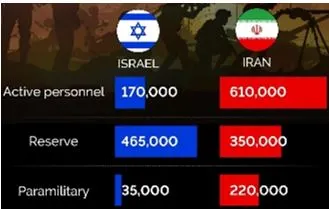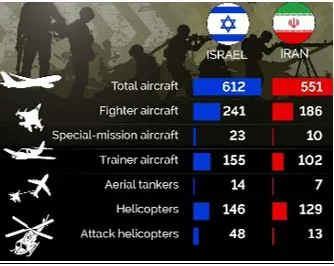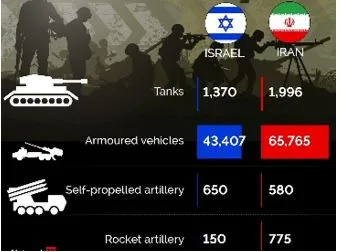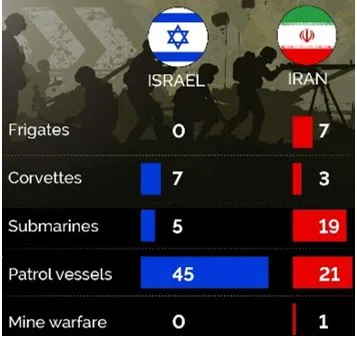

3rd October 2024 (9 Topics)
Mains Issues
Context
Iran’s missile attack on Israel has stoked fears of a wider conflict in West Asia.
Why are Israel and Iran enemies?
- Israel and Iran were allies until the 1979 Islamic revolution in Iran,
- They became enemies primarily due to the ideological shift following the 1979 Islamic Revolution in Iran, which transformed the country into a regime that opposes Israel’s existence.
- Iran openly denies Israel's right to exist, referring to it as a "cancerous tumor" that must be destroyed.
- Israel perceives Iran as an existential threat due to its support for militant groups like Hezbollah and Hamas, which aim to undermine Israeli security.
- Additionally, concerns over Iran's nuclear program, which Israel fears could lead to the development of nuclear weapons, further exacerbate tensions between the two nations.
What happened?
- Tehran fired roughly 200 ballistic missiles in an unprecedented assault on Israel, taking the region closer to a full-scale war.
- Israel, which largely intercepted the missiles with the help of its allies, has vowed retaliation against Iran. Tehran has also promised to strike back if Israel attacks.
- Iran’s Reasons:
- Iransaid it launched a barrage of missiles against Israel in response to the assassination of the Lebanese group Hezbollah leader Hassan Nasrallah and Islamic Revolutionary Guard Corps (IRGC) commander Abbas Nilforoushan, and the killing of Hamas leader Ismail Haniyeh in Tehran in July.
- It also said the attack was a response to Israel’s deadly strikes in Gaza and Lebanon.
India's Concerns
As the conflict in the Middle East escalates, particularly with Israel's offensive in Gaza and its implications for regional stability, India finds itself navigating a complex landscape of diplomatic, economic, and security concerns. While India has called for restraint and the protection of civilians, several broader issues warrant attention.
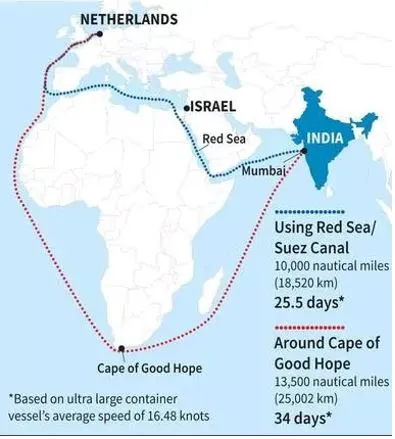
- Trade Troubles: The potential for an Israel-Iran conflict poses significant risks for global trade, particularly in the Red Sea region, a vital shipping route for oil and goods. The Yemen-based Houthis have already escalated attacks on vessels in this area, threatening maritime security.
- A full-blown war would mean diverting the shipments through Cape of Good Hope to avoid attacks. Moreover, the blocking of the Strait of Hormuz through which India gets its LNG from Qatar and oil from Iraq and Saudi Arabia could be another challenge.
- Hormuz, located between Oman and Iran, connects the Persian Gulf with the Gulf of Oman and the Arabian Sea. Hormuz is the world’s most important oil chokepoint because large volumes of oil flow through the Strait.
- Expensive oil: Iran is a powerhouse in the global oil market as a key member of OPEC, and the recent missile strikes have spooked oil markets. Despite rising oil imports from Russia, India also depends on Middle East for oil and gas imports. The share of Middle Eastern oil in India’s August crude imports rose to 44.6% from 40.3% in July.
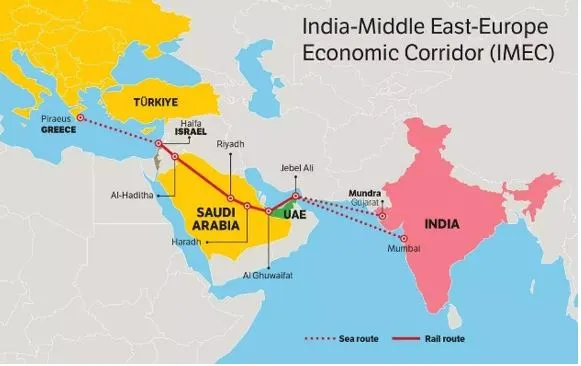
-
- Iraq, Saudi Arabia, the UAE and Kuwait are main Middle Eastern suppliers of oil to India.
- Threatened IMEC Plan: The Iran-Israel war could impede the progress of the India-Middle East-Europe Corridor (IMEC), which was announced last year during the G20 meeting in New Delhi.
- The IMEC plan comprises an Eastern Corridor connecting India to the Gulf region and a Northern Corridor connecting the Gulf region to Europe. It will include a railway and ship-rail transit network, as well as road transport routes.
Comparative analysis of the military capabilities of Israel and Iran
|
|
Iran's Missiles |
Israel's Missile Defense Systems |
|
|
Military Strength
|
Iran boasts a larger military force, comprising 610,000 active personnel, 350,000 reservists, and 220,000 paramilitary forces. |
Israel has 170,000 active military personnel, along with 465,000 reserves and 35,000 paramilitary forces. |
|
|
Air power
|
Iran has a total of 551 aircraft, comprising 186 fighter jets and 129 helicopters, of which 13 are designated as attack helicopters |
Israel operates 612 aircraft, including 241 fighter jets and 146 helicopters, with 48 classified as attack helicopters. Notably, Israel's air power includes 23 special-mission aircraft, enhancing its operational flexibility. |
|
|
Land forces
|
Iran operates 1,996 tanks and a larger fleet of 65,765 armored vehicles. |
Israel maintains 1,370 tanks and 43,407 armored vehicles, in addition to 650 self-propelled artillery units and 150 rocket artillery systems. |
|
|
Naval capabilities
|
Iran has seven frigates and three submarines, along with 19 patrol vessels and one mine warfare vessel, showcasing a stronger naval presence in the region. |
Israel's naval capabilities are relatively limited, with no frigates and five submarines, along with seven corvettes and 45 patrol vessels. |
|
|
Important Missiles |
|
|
|


Mains Issues
Context
Climate activist Sonam Wangchuk is protesting for Ladakh's inclusion in the Sixth Schedule of the Indian Constitution. This movement echoes similar demands from Arunachal Pradesh and Manipur for greater autonomy and protections for tribal populations. These developments have sparked renewed discussions on asymmetrical federalism in India, as the Fifth and Sixth Schedules highlight the varying degrees of autonomy granted to different regions.
What is Asymmetrical Federalism?
- Asymmetrical federalism refers to a system where some states or regions enjoy greater autonomy and special provisions than others.
- Unlike symmetrical federations such as the United States or Australia, where all states hold the same powers, India’s federalism allows for diverse arrangements tailored to specific historical and cultural contexts.
- This model is crucial for addressing the unique needs of tribal populations, particularly in northeastern India.
Historical Context of the Fifth and Sixth Schedules
- The roots of the Fifth and Sixth Schedules can be traced back to British colonial policies.
- Prior to British rule, tribal populations in India enjoyed significant autonomy over their ancestral lands and customary laws.
- However, British forest policies and land regulations disrupted these traditional rights, leading to various tribal uprisings such as the Kol rebellion (1831-32), Santhal revolt (1885), Munda Rebellion (1899-1900) and Bastar rebellion (1911).
- In response to growing discontent, the Government of India Act, 1935, established ‘excluded’ and ‘partially excluded’ areas, where legislative powers were vested in governors. These historical precedents laid the groundwork for the Fifth and Sixth Schedules in the Indian Constitution.
- Fifth Schedule: This schedule applies to ‘scheduled areas’ primarily inhabited by tribal populations.
- The President of India can declare these areas based on criteria such as tribal majority and economic backwardness.
- The Fifth Schedule grants specific powers to the Governor, including the regulation of land transfers and the establishment of Tribes Advisory Councils (TAC) to advise on welfare and advancement initiatives.
- Sixth Schedule: Applicable to ‘tribal areas’ in Assam, Meghalaya, Mizoram, and Tripura, the Sixth Schedule provides for the creation of Autonomous District Councils (ADCs).
- These councils have legislative powers to regulate land use, inheritance, and social customs, thereby ensuring a degree of self-governance for tribal populations.
- The ADCs can also manage local infrastructure and financial matters, which enhances local autonomy.
Special Provisions for Northeastern States
- Beyond the Fifth and Sixth Schedules, several northeastern states have special provisions under Part XXI of the Constitution.
- Articles 371A to 371H establish protections for local customs, governance structures, and responsibilities of state governors to promote development and maintain law and order.
- These are contained in Articles 371A (Nagaland), 371B (Assam), 371C (Manipur), 371F (Sikkim), 371G (Mizoram) and 371H (Arunachal Pradesh).
Need for Further Reforms
Despite the constitutional safeguards, challenges remain regarding the actual autonomy of Fifth and Sixth Schedule areas:
- Limited Practical Autonomy: The regulations made by governors in scheduled areas require approval from the Central government, which can undermine local governance. Political differences between parties at different levels can further complicate the situation.
- Unnotified ST Habitations: Many tribal habitations across India are not recognized as ‘scheduled areas,’ denying them constitutional protections and rights. A systematic effort to notify these areas is essential.
- Pending Legislative Reforms: The 125th Constitutional Amendment Bill (2019), aimed at enhancing the powers of ADCs, is still pending. Timely passage of this bill is crucial to empower local governance structures effectively.
- Growing Demands for Inclusion: Recent resolutions from state assemblies in Arunachal Pradesh and Manipur call for their inclusion in the Sixth Schedule, along with similar demands from Ladakh. Addressing these demands promptly is vital to protect tribal interests.
- Forest Rights Recognition: The implementation of the Forest Rights Act, 2006, should be ensured across the country, particularly in Fifth and Sixth Schedule areas, to recognize the traditional rights of tribal communities over forest lands.


Mains Issues
Context
Securities and Exchange Board of India (SEBI) has announced new measures to strengthen the framework for index derivatives trading in India. These changes aim to protect small investors and enhance market stability, especially amid rising concerns about speculative trading practices.
Key Changes in Derivative Trading
- Reduction of Weekly Expiries: The number of weekly expiries for index derivative contracts will be reduced to one per benchmark index per exchange. Currently, exchanges offer 18 weekly contracts each month. This change aims to curb speculative trading and reduce risks from uncovered options.
- Increased Contract Sizes: The minimum trading amount for derivatives will rise from Rs 5-10 lakh to Rs 15 lakh. This increase is intended to ensure that investors are taking on appropriate risks in the derivatives market. In the future, the contract value may further adjust to between Rs 15 lakh and Rs 20 lakh.
- Higher Margin Requirements: To address volatility on expiry days, Sebi will introduce an additional extreme loss margin (ELM) of 2% for all open short options on expiry day. This measure is designed to protect investors from severe market fluctuations during busy trading sessions.
- Upfront Collection of Premiums: From February 1, 2025, brokers must collect option premiums upfront. This shift discourages excessive intraday leverage, ensuring that investors have sufficient collateral to cover their positions.
- Removal of Calendar Spread Benefits: The practice of calendar spreads—offsetting positions across different expiries—will be eliminated for contracts expiring on the same day. This aims to reduce speculative trading, particularly on expiry days.
- Intraday Monitoring of Position Limits: Effective April 1, 2025, stock exchanges will begin monitoring position limits for equity index derivatives multiple times throughout the trading day. This change helps ensure that traders do not exceed permissible limits without detection.
Impact on Retail Investors
- Curbing Speculation: The increase in contract sizes is expected to deter speculative trading, especially among smaller retail investors who may not have the financial capacity to manage larger losses.
- Lower Participation in Options Trading: The reduction in weekly expiries and the elimination of calendar spread benefits may lead to decreased retail participation in options trading. Analysts believe this could stabilize the market by reducing high-frequency trading and speculation.
- Gradual Implementation for Stability: The phased rollout of these measures allows the market to adjust gradually, preventing sudden shocks and fostering a healthier trading environment.
- Reassessing Trading Strategies: Retail investors will need to rethink their trading strategies, particularly regarding rollover timing and margin management in light of these new rules.
Fact Box: About Futures and Options Trading
|


Prelims Articles
Context
India’s monsoon season concluded, with the country receiving 8% above-normal rainfall for the June-September period, according to the India Meteorological Department (IMD).
Performance
- Rainfall Statistics: The all-India cumulative rainfall from June to September stood at 935 mm, which is 8% above the normal rainfall of 870 mm. This surplus indicates a strong monsoon season, significantly benefiting agricultural productivity.
- Soil Moisture Conditions: According to the agriculture department, root zone soil moisture levels were either better than or comparable to the average of the past nine years in several key states, including Karnataka, Andhra Pradesh, Tamil Nadu, Telangana, Gujarat, Rajasthan, Uttar Pradesh, most parts of Madhya Pradesh, Chhattisgarh, Punjab, and southern Haryana.
- Regional Variations: However, soil moisture levels were found to be below the nine-year average in northern Bihar, certain areas of Jharkhand, and northern West Bengal, highlighting regional disparities in moisture availability.
- There were 69 low-pressure days this season, compared to the normal of 55.
- Fourteen low-pressure systems formed, and six of these intensified into depressions, against a normal of 5-6.
- The Madden Julian Oscillation, an eastward-moving system of rain-bearing winds and clouds, stayed in a favourable phase longer than usual, sustaining active monsoon conditions.
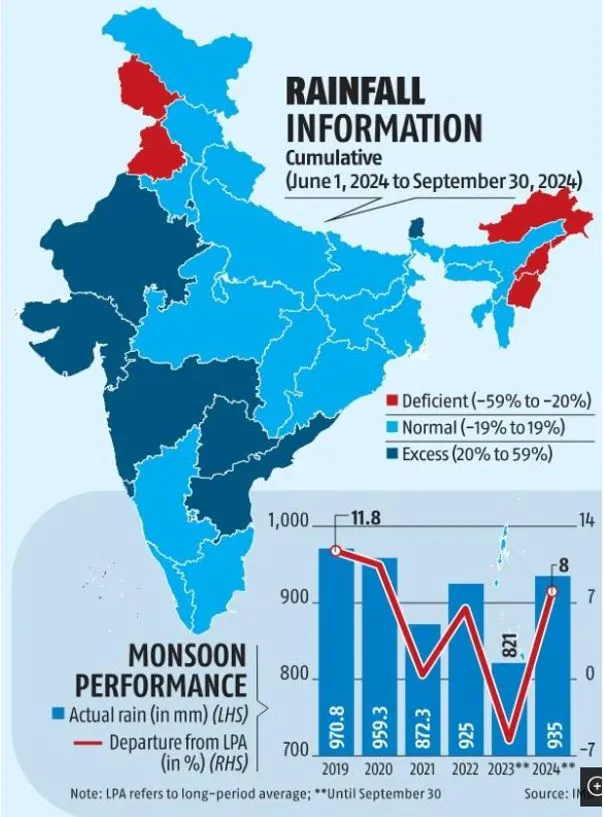
About Indian Summer Monsoon
- The monsoon season brings in 75% of India’s annual rainfall, watering crops, filling reservoirs, and driving the bulk of India's economy.
- June and July are critical months for planting kharif crops like rice, pulses, oilseeds, and cotton.
- The Indian Summer Monsoon (Southwest Monsoon) is caused by the differential heating of land and water.
- In summer, the Asian land mass heated up to form a low-pressure system, which attracted winds from the Arabian sea and Bay of Bengal, which were at lower temperatures and thus high-pressure systems.
- Energetics theory of the monsoon:
- Solar Radiation and Temperature Differences: The tilt of the Earth's axis leads to varying solar radiation across the globe. During summer in the northern hemisphere, land masses, especially over India and Central Asia, absorb more heat than surrounding oceans, resulting in a significant temperature gradient.
- Development of Low Pressure: The intense heating over the land creates a low-pressure zone. Warm air rises, leading to a reduction in atmospheric pressure at the surface. This contrasts with the relatively cooler, high-pressure regions over the oceans.
- Shifting ITCZ: The intertropical convergence zone (ITCZ), which is a band of low pressure near the equator where trade winds meet, shifts northward during this period. This movement is crucial as it brings moist air from the oceans toward the land.
- Moisture and Rainfall: As the ITCZ moves north and the southeast and northeast trade winds converge, they bring moisture-laden air over the Indian subcontinent. When this air rises due to the low pressure, it cools and condenses, resulting in heavy rainfall characteristic of the monsoon season.
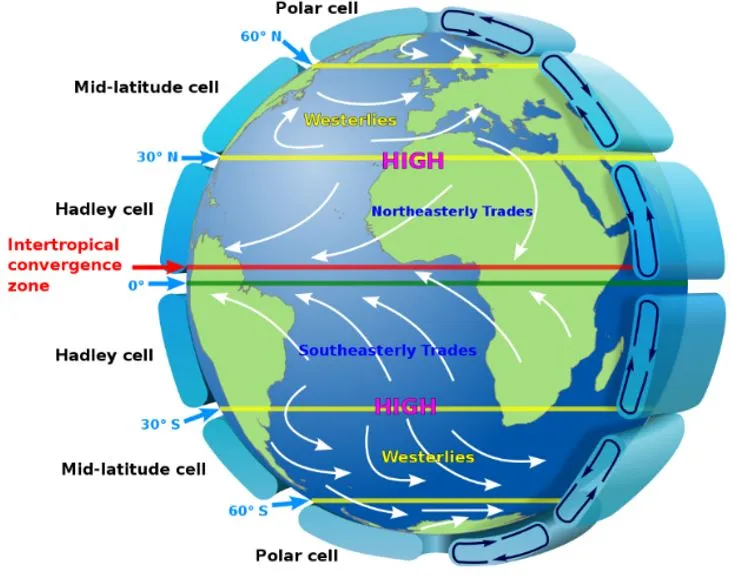
- Impact of the Coriolis Effect: As the southeast trade winds cross the Equator, they are influenced by the Coriolis effect, which causes them to deflect towards the east. This deflection alters their path, resulting in the winds blowing from the southwest toward India. As these winds travel over the warm waters of the Arabian Sea, they pick up significant moisture, making them a vital source of precipitation for the region.
- Arms of Southwest Monsoon: When the moist southwest trade winds reach the Indian peninsula, they trigger the onset of the southwest or Indian summer monsoon. The winds split into two distinct arms:
- Arabian Sea Arm: This arm travels over the Arabian Sea and brings heavy rainfall to India’s western coast, affecting states like Gujarat, Maharashtra, and Kerala.
- Bay of Bengal Arm: The other arm moves over the Bay of Bengal, striking the eastern coast of India and delivering rain to regions such as West Bengal and the southern slopes of the Shillong Plateau.
- Factors such as ocean temperatures, land-sea contrasts, and even global phenomena like El Niño can influence the monsoon's strength and duration.


Prelims Articles
Prime Minister Shri Narendra Modi launched the Dharti Aaba Janjatiya Gram Utkarsh Abhiyan (DAJGUA).
What is Dharti Aaba Janjatiya Gram Utkarsh Abhiyan (DAJGUA)?
- Dharti Aaba Janjatiya Gram Utkarsh Abhiyan, named after tribal icon Birsa Munda, aims to attain saturation of critical gaps in social infrastructure, health, education, livelihood, through 25 interventions implemented by various 17 Ministries and Departments of Government of India.
- Coverage: The Abhiyan will cover around 63,843 villages benefitting more than 5 crore tribal people in 549 districts and 2,911 blocks spread across all tribal majority villages and aspirational blocks in 30 States/UTs.
- It has been planned based on the learning and success of PM-JANMAN, which was launched by the Prime Minister on Janjatiya Gaurav Divas on 15th November, 2023.
- With a budget outlay of Rs. 24,104 crores, the scheme focuses on the Particularly Vulnerable Tribal Groups (PVTG) population.
About PM-JANMAN
- PM-JANMAN is aimed at addressing the needs of Particularly Vulnerable Tribal Groups (PVTGs) across India, making it the largest Central scheme targeted at tribal communities in terms of financial outlay.
- The scheme will focus on various essential facilities including:
- Housing: Approximately 4.9 lakh pucca houses will be constructed at a cost of Rs 2.39 lakh per house.
- Education: Establishment of 500 hostels costing Rs 2.75 crore per unit, and setting up 2,500 Anganwadi centres.
- Connectivity: Installation of mobile towers in 3,000 villages and development of 8,000 km of road connectivity.
- Health and Nutrition: Ensuring access to healthcare through mobile medical units and wellness centres set up by the Ministry of Ayush.
- Livelihood Opportunities: Skill and vocational training initiatives by the Ministry of Skill Development and Entrepreneurship to promote sustainable livelihoods.
- Financial Allocation and Implementation: The scheme is funded with Rs 15,336 crore from the Centre and Rs 8,768 crore from the states. It involves coordination among nine ministries to ensure effective implementation of various interventions aimed at uplifting PVTGs.
Government’s welfare outreach to ST communities
- Eklavya Model Residential Schools (EMRS), established to provide quality education to ST students in residential schools, were allocated Rs 6,399 crore.
- The post-matric scholarship for ST studentsalso saw a rise in its allocation.
- PM DAKSH scheme, which is aimed at skilling people from the SC and ST communities, saw its allocation increase from Rs 92.47 crore to Rs 130 crore.
- National Action for Mechanised Sanitation Ecosystem (NAMASTE) scheme, aimed at eliminating manual scavenging by replacing it with mechanised cleaning of sewers, was allocated Rs 116.94 crore
- Other schemes:
- PM JanjatiyaVikas Mission (PMJVM)
- National Overseas Scholarship Scheme for SCs
Fact Box:Birsa Munda
|


Prelims Articles
Context
Swachh Bharat Mission has successfully completed 10 years on October 2.
What is Swachh Bharat Mission?
- The Swachh Bharat Mission (SBM) was launched on October 2, 2014, to eliminate open defecation, improve solid waste management and to create Open Defecation Free (ODF) villages.
- The Central government launched the second edition or the SBM 2.0 in 2021.
- The mission was divided into:
- SBM-Gramin for villages (executed by the Ministry of Drinking Water and Sanitation)
- SBM-Urban for cities (executed by Ministry of Housing and Urban Affairs respectively)
- SBM’s main goal was to make India “Open defecation-free” (ODF), for which crores of household and community toilets had to be constructed.
- ODF: A city/ ward can be notified/ declared as an ODF city/ ODF ward if, at any point of the day, not a single person is found defecating in the open.
Key-Achievements of SBM
As SBM completes a decade, here are some key accomplishments:
- Open Defecation Free (ODF) Status for Villages: One of the most notable achievements of the SBM is the dramatic reduction in open defecation in rural India. The mission aimed for an ODF India by 2019, prompting a massive toilet construction drive. The number of people practicing open defecation has decreased from 550 million to 320 million. Five states and over 200,000 villages have been declared ODF, marking a significant cultural shift in sanitation practices.
- Improved Toilet Coverage: SBM's focus on toilet construction has led to a substantial increase in sanitation access, particularly in rural areas. Toilet coverage rose from 45% in 2004-05 to 82.5% by 2019-21, improving public health, especially for women and children, and enhancing safety and dignity.
- Reduction in Infant Mortality: Studies have shown a correlation between improved sanitation and declining infant mortality rates. Research indicates that the SBM has likely prevented 60,000-70,000 infant deaths annually, as areas with higher toilet coverage report lower child mortality rates.
- Rise of ODF Plus Villages: Building on the success of ODF status, the SBM is now focusing on ODF Plus villages, which implement solid and liquid waste management systems. As of September 2023, over 4.4 lakh villages have achieved this status, promoting comprehensive sanitation and environmental sustainability.
- Waste Management Initiatives: SBM has introduced initiatives to enhance waste management through the principles of Reduce, Reuse, and Recycle. The GOBARdhan scheme promotes the conversion of biodegradable waste into resources like biogas. Additionally, numerous units for plastic waste management have been established, showcasing innovative waste utilization methods.
- Swachh Survekshan: To promote urban sanitation, the Ministry of Urban Development launched the annual Swachh Survekshan, which ranks cities based on cleanliness and waste management. This initiative has fostered competition among cities to improve their sanitation efforts, significantly enhancing urban cleanliness.
- Behavioural Change: Perhaps the most profound achievement of the SBM is its success in changing public attitudes towards sanitation. Through extensive outreach campaigns and community mobilization, sanitation has become a national priority, instilling a sense of responsibility among citizens.


Editorials
Context
Violence in the Middle East is escalating, particularly following the assassination of Hezbollah leader. This incident has heightened tensions across multiple conflict fronts, including the Gaza Strip, West Bank, northern borders, and regional powers, as various groups respond to ongoing military operations.
Escalating Conflicts
- Multiple Conflict Fronts: Israel is currently engaged in conflicts across five interconnected fronts, including Gaza, the West Bank, and neighboring regions. This multifaceted warfare raises concerns about a broader regional conflict.
- Technological Warfare: Israel has utilized advanced technology to target adversaries effectively, exemplified by precise strikes that have disrupted operations within secure locations. This operational strategy reflects a commitment to leveraging modern military capabilities.
- Rising Casualties: The ongoing military operations have resulted in significant civilian casualties, exceeding 41,000, including a mix of combatants and non-combatants. This loss of life has attracted international scrutiny and calls for a ceasefire.
Regional Dynamics
- Role of Regional Powers: Various regional entities are leveraging the conflict to assert influence, with one group using missile capabilities to threaten stability along shared borders. This dynamic complicates peace efforts and increases local tensions.
- Public Sentiment and International Pressure: While initial support for military actions was present, international public opinion has shifted towards demanding a ceasefire due to rising civilian casualties. This changing sentiment is pressuring regional governments to reconsider their stances.
- Hezbollah's Position: The militant group has been positioned as a key player in regional resistance, demonstrating both military effectiveness and social integration within its home state. Its actions are indicative of broader strategic goals, complicating conflict resolution.
Challenges to Peace
- Ceasefire Obstacles: Despite widespread calls for a ceasefire, significant geopolitical hurdles prevent meaningful dialogue. The perception of peace as a form of surrender hampers negotiations among key players involved in the conflict.
- Absence of Strategic Incentives: The lack of effective diplomatic strategies, particularly a balanced approach involving incentives and deterrents, hampers progress. This absence limits the potential for a coordinated international response.
- Future of Regional Stability: Given the ongoing violence and entrenched positions, prospects for resolution appear dim. The intertwined nature of the conflicts suggests that unless significant shifts occur, regional instability is likely to persist.
Practice Question
Q. Analyze the implications of technological advancements in military strategies on the ongoing conflicts in the Middle East.


Editorials
Context
In a recent development, Bombay High Court ruled against an amendment to the Information Technology Rules, which sought to empower the Union government’s "Fact Check Unit" (FCU) to determine what constitutes false or misleading information regarding its operations. The ruling emphasized the importance of free speech and struck down provisions that would allow the government undue control over online content.
Legal Grounds for the Ruling
- Unconstitutionality of Rule 3(1)(b)(v): The court declared the amendment unconstitutional, asserting it infringed on citizens’ rights to free speech by allowing the government to dictate what information could be deemed fake. This legal perspective aligns with constitutional protections under Article 19(1)(a).
- Chilling Effect on Intermediaries: The court recognized that the requirement for intermediaries to heed the FCU's directives imposed a chilling effect on free expression. The ruling highlighted that intermediaries, fearing loss of "safe harbour," would likely prioritize business interests over users’ rights.
- Failure to Provide Alternatives: The petitioners argued that the government had failed to explore less intrusive measures to tackle The court acknowledged that constitutional limits exist and that the government did not justify its approach within these boundaries.
Implications for Free Speech
- Role of Intermediaries: The judgment reinforced the concept that intermediaries should not bear the burden of censorship. It underscored that without safe harbour protections, platforms might curtail user content to avoid liability, ultimately undermining free speech.
- Marketplace of Ideas: The ruling reiterated that free speech thrives in a marketplace of ideas where citizens can engage in open discourse. The state’s attempts to regulate content were deemed incompatible with the foundational principle that citizens are entitled to express diverse viewpoints.
- Lack of Constitutional Grounds for Censorship: The High Court noted that the government’s justification for censoring false or misleading information did not align with any permissible restrictions outlined in Article 19(2). The absence of constitutional backing for the Rule highlighted its potential for arbitrary censorship.
Democratic Principles at Stake
- Impact on Democracy: The judgment underscored the importance of safeguarding democratic principles against state overreach in information control. Allowing such measures could erode the fundamental tenets of free expression that are essential to democracy.
- Recognition of Citizen Autonomy: Justice Chandurkar emphasized that free speech is integral to human dignity and autonomy, asserting that citizens should have the right to engage in free thought without state interference.
- Censorship and Public Discourse: The ruling served as a warning against the dangers of censorship, highlighting that permitting the government to act as an arbiter of truth risks stifling public discourse and debate crucial for a vibrant democracy.
Practice Question
Q. Discuss the implications of the Bombay High Court's ruling against the amendment to the Information Technology Rules on the principles of free speech and democratic governance in India. How does this ruling relate to the constitutional protections under Article 19?


Editorials
Context
India's National Mission on Interdisciplinary Cyber-Physical Systems (NM-ICPS) has made significant advancements in integrating technology across various sectors. The initiative aims to establish India as a global leader in Cyber-Physical Systems (CPS) by fostering innovation and translational research, thereby contributing to economic growth and technological self-reliance.
Mission Overview
- Strategic Goals: Launched in December 2018 with a budget of Rs 3,660 crore, NM-ICPS aims to merge the physical world with computational systems, driving advancements in areas such as AI, robotics, and cybersecurity.
- Innovative Mechanisms: The mission has established Technology Innovation Hubs in 25 institutions, operating as Section 8 companies. This structure provides the necessary operational freedom to translate research into market-ready technologies aligned with national priorities.
- Impact on Employment: In just six years, NM-ICPS has led to the creation of over 1,500 new technologies and products from more than 650 startups, resulting in over 16,000 jobs and training for 150,000 individuals in entrepreneurship.
Notable Innovations
- Cybersecurity Solutions: The IT-OT Security Operations Center (SOC) at IIT Kanpur offers comprehensive cyber threat protection, demonstrating a cost-effective solution for safeguarding critical infrastructure. It integrates advanced technologies to enhance security measures across various sectors.
- Autonomous Navigation Advancements: The TiHAN Foundation at IIT Hyderabad focuses on developing autonomous navigation systems, providing a testbed that supports both aerial and terrestrial applications. Collaborations with institutions and industry facilitate advanced research and commercialization.
- Sustainable Agriculture Technologies: AWaDH at IIT Ropar is developing innovative solutions for agriculture, including the world's first "Digital Entomologist" and technologies for water management. Collaborations with global partners enhance its capabilities and promote sustainable practices.
Emerging Startups and Future Directions
- Startup Ecosystem: The mission has fostered a vibrant startup ecosystem, with companies like Botlabs Dynamics and COMRADO Aerospace developing cutting-edge technologies for defense and surveillance applications, showcasing the commercial viability of innovations.
- Advancements in Semiconductor Technology: Mindgrove Technologies is pioneering open-source System-on-Chips (SoCs) for secure IoT environments, offering competitive advantages in cost and performance for smart devices, reinforcing India's position in semiconductor technology.
- Commercialization Efforts: Moving forward, innovation hubs are expected to achieve financial autonomy through commercialization. Collaborative projects like “Generative AI for Bharat” will focus on developing foundational models in multiple Indian languages, furthering India's technological landscape.
Practice Question
Q. Discuss the significance of India's National Mission on Interdisciplinary Cyber-Physical Systems (NM-ICPS) in fostering technological innovation. How do its initiatives align with national priorities for economic growth and self-reliance?


